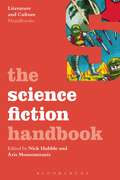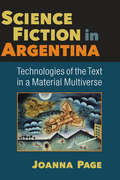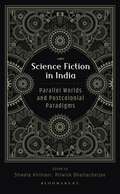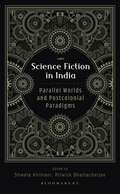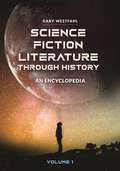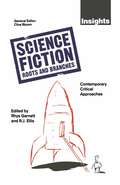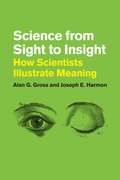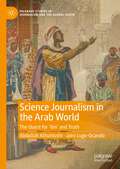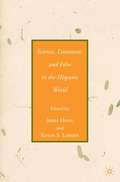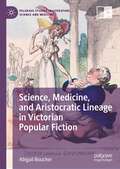- Table View
- List View
The Science Fiction Handbook (Literature and Culture Handbooks)
by Nick Hubble Aris MousoutzanisAs we move through the 21st century, the importance of science fiction to the study of English Literature is becoming increasingly apparent. The Science Fiction Handbook provides a comprehensive guide to the genre and how to study it for students new to the field. In particular, it provides detailed entries on major writers in the SF field who might be encountered on university-level English Literature courses, ranging from H.G. Wells and Philip K. Dick, to Doris Lessing and Geoff Ryman. Other features include an historical timeline, sections on key writers, critics and critical terms, and case studies of both literary and critical works. In the later sections of the book, the changing nature of the science fiction canon and its growing role in relation to the wider categories of English Literature are discussed in depth introducing the reader to the latest critical thinking on the field.
Science Fiction in Argentina: Technologies of the Text in a Material Multiverse
by Joanna PageIt has become something of a critical commonplace to claim that science fiction does not actually exist in Argentina. This book puts that claim to rest by identifying and analyzing a rich body of work that fits squarely in the genre. Joanna Page explores a range of texts stretching from 1875 to the present day and across a variety of media-literature, cinema, theatre, and comics-and studies the particular inflection many common discourses of science fiction (e.g., abuse of technology by authoritarian regimes, apocalyptic visions of environmental catastrophe) receive in the Argentine context. A central aim is to historicize these texts, showing how they register and rework the contexts of their production, particularly the hallmarks of modernity as a social and cultural force in Argentina. Another aim, held in tension with the first, is to respond to an important critique of historicism that unfolds in these texts. They frequently unpick the chronology of modernity, challenging the linear, universalizing models of development that underpin historicist accounts. They therefore demand a more nuanced set of readings that work to supplement, revise, and enrich the historicist perspective.
Science Fiction in India: Parallel Worlds and Postcolonial Paradigms
by Shweta Khilnani Ritwick BhattacharjeeIndian Science Fiction has evolved over the years and can be seen making a mark for itself on the global scene. Dalit speculative fiction writer and editor Mimi Mondal is the first SF writer from India to have been nominated for the prestigious Hugo award. In fact, Indian SF addresses themes such as global climate change. Debates around G.C.C are not just limited to science fiction but also permeate in critical discussions on SF. This volume seeks to examine the different ways by which Indian SF narratives construct possible national futures. For this looking forward necessarily germinates from the current positional concerns of the nation. While some work has been done on Indian SF, there is still a perceptible lack of an academic rigor invested into the genre; primarily, perhaps, because of not only its relative unpopularity in India, but also its employment of futuristic sights. Towards the same, among other things, it proposes to study the growth and evolution of science fiction in India as a literary genre which accommodates the duality of the national consciousness as it simultaneously gazes ahead towards the future and glances back at the past. In other words, the book will explore how the tensions generated by the seemingly conflicting forces of tradition and modernity within the Indian historical landscape are realized through characteristic tropes of SF storytelling. It also intends to look at the interplay between the spatio-temporal coordinates of the nation and the SF narratives produced within to see, firstly, how one bears upon the other and, secondly, how processes of governance find relational structures with such narratives. Through these, the volume wishes to interrogate how postcolonial futures promise to articulate a more representative and nuanced picture of a contemporary reality that is rooted in a distinct cultural and colonial past.
Science Fiction in India: Parallel Worlds and Postcolonial Paradigms
by Shweta Khilnani Ritwick BhattacharjeeNominated, 2023 Teaching Literature Book AwardIndian Science Fiction has evolved over the years and can be seen making a mark for itself on the global scene. Dalit speculative fiction writer and editor Mimi Mondal is the first SF writer from India to have been nominated for the prestigious Hugo award. In fact, Indian SF addresses themes such as global climate change. Debates around G.C.C are not just limited to science fiction but also permeate in critical discussions on SF. This volume seeks to examine the different ways by which Indian SF narratives construct possible national futures. For this looking forward necessarily germinates from the current positional concerns of the nation. While some work has been done on Indian SF, there is still a perceptible lack of an academic rigor invested into the genre; primarily, perhaps, because of not only its relative unpopularity in India, but also its employment of futuristic sights. Towards the same, among other things, it proposes to study the growth and evolution of science fiction in India as a literary genre which accommodates the duality of the national consciousness as it simultaneously gazes ahead towards the future and glances back at the past. In other words, the book will explore how the tensions generated by the seemingly conflicting forces of tradition and modernity within the Indian historical landscape are realized through characteristic tropes of SF storytelling. It also intends to look at the interplay between the spatio-temporal coordinates of the nation and the SF narratives produced within to see, firstly, how one bears upon the other and, secondly, how processes of governance find relational structures with such narratives. Through these, the volume wishes to interrogate how postcolonial futures promise to articulate a more representative and nuanced picture of a contemporary reality that is rooted in a distinct cultural and colonial past.
Science Fiction in Translation: Perspectives on the Global Theory and Practice of Translation (Studies in Global Science Fiction)
by Ian CampbellScience Fiction in Translation: Perspectives on the Global Theory and Practice of Translation focuses on the process of translation and its implications. The volume explores the translation of works of science fiction (SF) from one language to another and the translation of SF tropes, terms, and ideas of SF theory into cultures outside the West. Providing a comprehensive examination of the state of translation into English, the essays consider how representative the body of translated work of SF is from the source language/culture. It also considers the social, political, and economic choices in selecting a work to translate. The book illustrates the dramatic growth both in SF production outside the Anglosphere, the translation of works from other languages into English, and the practice of translating English-language SF into other languages. Altogether, the essays map the theory, practice, and business of SF translation around the world.
Science Fiction: Its Criticism and Teaching (Routledge Library Editions: Science Fiction #2)
by Patrick ParrinderThis book, first published in 1980, examines issues such as the definition of the genre, its function as social criticism and as an embodiment and critique of the scientific outlook. In order to work towards a more comprehensive view of the genre, the author analyses science fiction by turns as a mode of popular literature, as a socially responsible and quasi-realistic form of writing, and as a home for a fantastic and parodic use of language. How much are ‘future histories’, to name but one type of SF, the answer to a frustration of the epic impulse? These questions and more are closely examined in this lively and informative book.
Science Fiction Literature through History [2 volumes]: An Encyclopedia [2 volumes]
by Gary WestfahlThis book provides students and other interested readers with a comprehensive survey of science fiction history and numerous essays addressing major science fiction topics, authors, works, and subgenres written by a distinguished scholar.This encyclopedia deals with written science fiction in all of its forms, not only novels and short stories but also mediums often ignored in other reference books, such as plays, poems, comic books, and graphic novels. Some science fiction films, television programs, and video games are also mentioned, particularly when they are relevant to written texts. Its focus is on science fiction in the English language, though due attention is given to international authors whose works have been frequently translated into English.Since science fiction became a recognized genre and greatly expanded in the 20th century, works published in the 20th and 21st centuries are most frequently discussed, though important earlier works are not neglected. The texts are designed to be helpful to numerous readers, ranging from students first encountering science fiction to experienced scholars in the field.
Science Fiction Literature through History [2 volumes]: An Encyclopedia [2 volumes]
by Gary WestfahlThis book provides students and other interested readers with a comprehensive survey of science fiction history and numerous essays addressing major science fiction topics, authors, works, and subgenres written by a distinguished scholar.This encyclopedia deals with written science fiction in all of its forms, not only novels and short stories but also mediums often ignored in other reference books, such as plays, poems, comic books, and graphic novels. Some science fiction films, television programs, and video games are also mentioned, particularly when they are relevant to written texts. Its focus is on science fiction in the English language, though due attention is given to international authors whose works have been frequently translated into English.Since science fiction became a recognized genre and greatly expanded in the 20th century, works published in the 20th and 21st centuries are most frequently discussed, though important earlier works are not neglected. The texts are designed to be helpful to numerous readers, ranging from students first encountering science fiction to experienced scholars in the field.
Science Fiction Roots And Branches: Contemporary Critical Approaches (Insights)
by Rhys Garnett R J EllisScience Fiction TV (Routledge Television Guidebooks)
by J. P. TelotteThe first in the Routledge Television Guidebooks series, Science Fiction TV offers an introduction to the versatile and evolving genre of science fiction television, combining historical overview with textual readings to analyze its development and ever-increasing popularity. J. P. Telotte discusses science fiction’s cultural progressiveness and the breadth of its technological and narrative possibilities, exploring SFTV from its roots in the pulp magazines and radio serials of the 1930s all the way up to the present. From formative series like Captain Video to contemporary, cutting-edge shows like Firefly and long-lived popular revivals such as Doctor Who and Star Trek, Telotte insightfully tracks the history and growth of this crucial genre, along with its dedicated fandom and special venues, such as the Syfy Channel. In addition, each chapter features an in-depth exploration of a range of key historical and contemporary series, including: -Captain Video and His Video Rangers -The Twilight Zone -Battlestar Galactica -Farscape -Fringe Incorporating a comprehensive videography, discussion questions, and a detailed bibliography for additional reading, J. P. Telotte has created a concise yet thought-provoking guide to SFTV, a book that will appeal not only to dedicated science fiction fans but to students of popular culture and media as well.
Science Fiction TV (Routledge Television Guidebooks)
by J. P. TelotteThe first in the Routledge Television Guidebooks series, Science Fiction TV offers an introduction to the versatile and evolving genre of science fiction television, combining historical overview with textual readings to analyze its development and ever-increasing popularity. J. P. Telotte discusses science fiction’s cultural progressiveness and the breadth of its technological and narrative possibilities, exploring SFTV from its roots in the pulp magazines and radio serials of the 1930s all the way up to the present. From formative series like Captain Video to contemporary, cutting-edge shows like Firefly and long-lived popular revivals such as Doctor Who and Star Trek, Telotte insightfully tracks the history and growth of this crucial genre, along with its dedicated fandom and special venues, such as the Syfy Channel. In addition, each chapter features an in-depth exploration of a range of key historical and contemporary series, including: -Captain Video and His Video Rangers -The Twilight Zone -Battlestar Galactica -Farscape -Fringe Incorporating a comprehensive videography, discussion questions, and a detailed bibliography for additional reading, J. P. Telotte has created a concise yet thought-provoking guide to SFTV, a book that will appeal not only to dedicated science fiction fans but to students of popular culture and media as well.
Science from Sight to Insight: How Scientists Illustrate Meaning
by Alan G. Gross Joseph E. HarmonJohn Dalton’s molecular structures. Scatter plots and geometric diagrams. Watson and Crick’s double helix. The way in which scientists understand the world—and the key concepts that explain it—is undeniably bound up in not only words, but images. Moreover, from PowerPoint presentations to articles in academic journals, scientific communication routinely relies on the relationship between words and pictures. In Science from Sight to Insight, Alan G. Gross and Joseph E. Harmon present a short history of the scientific visual, and then formulate a theory about the interaction between the visual and textual. With great insight and admirable rigor, the authors argue that scientific meaning itself comes from the complex interplay between the verbal and the visual in the form of graphs, diagrams, maps, drawings, and photographs. The authors use a variety of tools to probe the nature of scientific images, from Heidegger’s philosophy of science to Peirce’s semiotics of visual communication. Their synthesis of these elements offers readers an examination of scientific visuals at a much deeper and more meaningful level than ever before.
Science from Sight to Insight: How Scientists Illustrate Meaning
by Alan G. Gross Joseph E. HarmonJohn Dalton’s molecular structures. Scatter plots and geometric diagrams. Watson and Crick’s double helix. The way in which scientists understand the world—and the key concepts that explain it—is undeniably bound up in not only words, but images. Moreover, from PowerPoint presentations to articles in academic journals, scientific communication routinely relies on the relationship between words and pictures. In Science from Sight to Insight, Alan G. Gross and Joseph E. Harmon present a short history of the scientific visual, and then formulate a theory about the interaction between the visual and textual. With great insight and admirable rigor, the authors argue that scientific meaning itself comes from the complex interplay between the verbal and the visual in the form of graphs, diagrams, maps, drawings, and photographs. The authors use a variety of tools to probe the nature of scientific images, from Heidegger’s philosophy of science to Peirce’s semiotics of visual communication. Their synthesis of these elements offers readers an examination of scientific visuals at a much deeper and more meaningful level than ever before.
Science from Sight to Insight: How Scientists Illustrate Meaning
by Alan G. Gross Joseph E. HarmonJohn Dalton’s molecular structures. Scatter plots and geometric diagrams. Watson and Crick’s double helix. The way in which scientists understand the world—and the key concepts that explain it—is undeniably bound up in not only words, but images. Moreover, from PowerPoint presentations to articles in academic journals, scientific communication routinely relies on the relationship between words and pictures. In Science from Sight to Insight, Alan G. Gross and Joseph E. Harmon present a short history of the scientific visual, and then formulate a theory about the interaction between the visual and textual. With great insight and admirable rigor, the authors argue that scientific meaning itself comes from the complex interplay between the verbal and the visual in the form of graphs, diagrams, maps, drawings, and photographs. The authors use a variety of tools to probe the nature of scientific images, from Heidegger’s philosophy of science to Peirce’s semiotics of visual communication. Their synthesis of these elements offers readers an examination of scientific visuals at a much deeper and more meaningful level than ever before.
Science from Sight to Insight: How Scientists Illustrate Meaning
by Alan G. Gross Joseph E. HarmonJohn Dalton’s molecular structures. Scatter plots and geometric diagrams. Watson and Crick’s double helix. The way in which scientists understand the world—and the key concepts that explain it—is undeniably bound up in not only words, but images. Moreover, from PowerPoint presentations to articles in academic journals, scientific communication routinely relies on the relationship between words and pictures. In Science from Sight to Insight, Alan G. Gross and Joseph E. Harmon present a short history of the scientific visual, and then formulate a theory about the interaction between the visual and textual. With great insight and admirable rigor, the authors argue that scientific meaning itself comes from the complex interplay between the verbal and the visual in the form of graphs, diagrams, maps, drawings, and photographs. The authors use a variety of tools to probe the nature of scientific images, from Heidegger’s philosophy of science to Peirce’s semiotics of visual communication. Their synthesis of these elements offers readers an examination of scientific visuals at a much deeper and more meaningful level than ever before.
Science from Sight to Insight: How Scientists Illustrate Meaning
by Alan G. Gross Joseph E. HarmonJohn Dalton’s molecular structures. Scatter plots and geometric diagrams. Watson and Crick’s double helix. The way in which scientists understand the world—and the key concepts that explain it—is undeniably bound up in not only words, but images. Moreover, from PowerPoint presentations to articles in academic journals, scientific communication routinely relies on the relationship between words and pictures. In Science from Sight to Insight, Alan G. Gross and Joseph E. Harmon present a short history of the scientific visual, and then formulate a theory about the interaction between the visual and textual. With great insight and admirable rigor, the authors argue that scientific meaning itself comes from the complex interplay between the verbal and the visual in the form of graphs, diagrams, maps, drawings, and photographs. The authors use a variety of tools to probe the nature of scientific images, from Heidegger’s philosophy of science to Peirce’s semiotics of visual communication. Their synthesis of these elements offers readers an examination of scientific visuals at a much deeper and more meaningful level than ever before.
Science from Sight to Insight: How Scientists Illustrate Meaning
by Alan G. Gross Joseph E. HarmonJohn Dalton’s molecular structures. Scatter plots and geometric diagrams. Watson and Crick’s double helix. The way in which scientists understand the world—and the key concepts that explain it—is undeniably bound up in not only words, but images. Moreover, from PowerPoint presentations to articles in academic journals, scientific communication routinely relies on the relationship between words and pictures. In Science from Sight to Insight, Alan G. Gross and Joseph E. Harmon present a short history of the scientific visual, and then formulate a theory about the interaction between the visual and textual. With great insight and admirable rigor, the authors argue that scientific meaning itself comes from the complex interplay between the verbal and the visual in the form of graphs, diagrams, maps, drawings, and photographs. The authors use a variety of tools to probe the nature of scientific images, from Heidegger’s philosophy of science to Peirce’s semiotics of visual communication. Their synthesis of these elements offers readers an examination of scientific visuals at a much deeper and more meaningful level than ever before.
Science in Modern Poetry: New Directions (Poetry &... #4)
by John HolmesOver the last thirty years, more and more critics and scholars have come to recognize the importance of science to literature. 'Science in Modern Poetry: New Directions' is the first collection of essays to focus specifically on what poets in the twentieth and twenty-first centuries have made of the scientific developments going on around them. In a collection of twelve essays, leading experts on modern poetry and on literature and science explore how poets have used scientific language in their poems, how poetry can offer new perspectives on science, and how the 'Two Cultures' can and have come together in the work of poets from Britain and Ireland, America and Australia. What does the poetry of a leading immunologist and a Nobel-Prize-winning chemist tell us about how poetry can engage with science? Scientific experiments aim to yield knowledge, but what do the linguistic and formal experiments of contemporary American poets suggest about knowledge in their turn? How can universities help to bring these different experimental cultures and practices together? What questions do literary critics need to ask themselves when looking at poems that respond to science? How did developments in biology between the wars shape modernist poetry? What did William Empson make of science fiction, Ezra Pound of the fourth dimension, Thomas Hardy of anthropology? How did modern poets from W. B. Yeats to Elizabeth Bishop and Judith Wright respond to the legacy of Charles Darwin? This book aims to answer these questions and more, in the process setting out the state of the field and suggesting new directions and approaches for research by students and scholars working on the fertile relationship between science and poetry today.
Science Journalism in the Arab World: The Quest for ‘Ilm’ and Truth (Palgrave Studies in Journalism and the Global South)
by Abdullah Alhuntushi Jairo Lugo-OcandoThis book examines the main issues and challenges that science journalism faces in the MENA region while analyzing how journalists in these countries cover science and engage with scientists. Most countries in the Middle East and North Africa region have set an ambitious goal for 2030: to transform their societies and become knowledge economies. This means modernizing institutions and encouraging people to embrace Science, Technology, Engineering and Mathematics as part of their daily lives. This books claims that the main vehicle to achieve this goal is science news reporting, as it continues to be the main platform to disseminate scientific knowledge to the general public. Simultaneously, it is also poorly equipped to achieve this task. Interviewing dozens of journalists, the authors looked at specific areas such as the gender divide and its effects on science news reporting as well as the role of religion and culture in shaping journalism as a political institution. The authors conclude that traditional normative assumptions as to why science reporting does not live up to expectations need to be reviewed in light of other more structural problems such as lack of skills and specialization in science communication in the region. In so doing, the book sets out to understand the past, present and future of science news in one of the most challenging regions in the world for journalists.
Science, Language, and Reform in Victorian Poetry: Political Dialects (The Nineteenth Century Series)
by Barbara BarrowBarrow’s timely book is the first to examine the link between Victorian poetry, the study of language, and political reform. Focusing on a range of literary, scientific, and political texts, Barrow demonstrates that nineteenth-century debates about language played a key role in shaping emergent ideas about popular sovereignty. While Victorian scientists studied the origins of speech, the history of dialects, and the barrier between human and animal language, poets such as Elizabeth Barrett Browning, Alfred Tennyson, and Thomas Hardy drew on this research to explore social unrest, the expansion of the electorate, and the ever-widening boundaries of empire. Science, Language, and Reform in Victorian Poetry recovers unacknowledged links between poetry, philology, and political culture, and contributes to recent movements in literary studies that combine historicist and formalist approaches.
Science, Language, and Reform in Victorian Poetry: Political Dialects (The Nineteenth Century Series)
by Barbara BarrowBarrow’s timely book is the first to examine the link between Victorian poetry, the study of language, and political reform. Focusing on a range of literary, scientific, and political texts, Barrow demonstrates that nineteenth-century debates about language played a key role in shaping emergent ideas about popular sovereignty. While Victorian scientists studied the origins of speech, the history of dialects, and the barrier between human and animal language, poets such as Elizabeth Barrett Browning, Alfred Tennyson, and Thomas Hardy drew on this research to explore social unrest, the expansion of the electorate, and the ever-widening boundaries of empire. Science, Language, and Reform in Victorian Poetry recovers unacknowledged links between poetry, philology, and political culture, and contributes to recent movements in literary studies that combine historicist and formalist approaches.
Science, Literature, and Film in the Hispanic World
by J. Hoeg K. LarsenDriven by such diverse advances as the Human Genome Project and the explosion of the World Wide Web, and also by the threat of human-inspired disasters such as global warming, the field of science and literature studies is currently undergoing an unprecedented expansion. The relations between science and literature have been and continue to be central to understanding Hispanic civilization and culture. In spite of this, Science, Literature, and Film in the Spanish-Speaking World is the first and only book to treat this new and dynamic field from an Hispanic perspective. This unique volume opens the door to an entirely new focus in the study of Hispanic literature and culture.
Science, Literature and Rhetoric in Early Modern England (Literary and Scientific Cultures of Early Modernity)
by David BurchellThese essays throw new light on the complex relations between science, literature and rhetoric as avenues to discovery in the seventeenth and eighteenth centuries. Scholars from a variety of disciplinary backgrounds examine the agency of early modern poets, playwrights, essayists, philosophers, natural philosophers and artists in remaking their culture and reforming ideas about human understanding. Analyzing the ways in which the works of such diverse writers as Shakespeare, Bacon, Hobbes, Milton, Cavendish, Boyle, Pope and Behn related to contemporary epistemological debates, these essays move us toward a better understanding of interactions between the sciences and the humanities during a seminal phase in the emergence of modern Western thought.
Science, Literature and Rhetoric in Early Modern England (Literary and Scientific Cultures of Early Modernity)
by David BurchellThese essays throw new light on the complex relations between science, literature and rhetoric as avenues to discovery in the seventeenth and eighteenth centuries. Scholars from a variety of disciplinary backgrounds examine the agency of early modern poets, playwrights, essayists, philosophers, natural philosophers and artists in remaking their culture and reforming ideas about human understanding. Analyzing the ways in which the works of such diverse writers as Shakespeare, Bacon, Hobbes, Milton, Cavendish, Boyle, Pope and Behn related to contemporary epistemological debates, these essays move us toward a better understanding of interactions between the sciences and the humanities during a seminal phase in the emergence of modern Western thought.
Science, Medicine, and Aristocratic Lineage in Victorian Popular Fiction (Palgrave Studies in Literature, Science and Medicine)
by Abigail BoucherScience, Medicine, and Lineage in Popular Fiction of the Long Nineteenth Century explores the dialogue between popular literature and medical and scientific discourse in terms of how they represent the highly visible an pathologized British aristocratic body. This books explores and complicates the two major portrayals of aristocrats in nineteenth-century literature: that of the medicalised, frail, debauched, and diseased aristocrat, and that of the heroic, active, beautiful ‘noble’, both of which are frequent and resonant in popular fiction of the long nineteenth century. Abigail Boucher argues that the concept of class in the long nineteenth century implicitly includes notions of blood, lineage, and bodily ‘correctness’, and that ‘class’ was therefore frequently portrayed as an empirical, scientific, and medical certainty. Due to their elevated and highly visual social positions, both historical and fictional aristocrats were frequently pathologized in the public mind and watched for signs of physical excellence or deviance. Using popular fiction, Boucher establishes patterns across decades, genres, and demographics and considers how these patterns react to, normalise, or feed into the advent of new scientific and medical understandings.
